Online Education: Implications and Challenges in the Philippines
VerifiedAdded on 2023/01/13
|12
|5247
|56
AI Summary
This paper discusses the implications and challenges of online education in the Philippines during the COVID-19 pandemic. It explores the shift to distance learning, the barriers faced by students, and the importance of equity and access in online education. The paper emphasizes the need for professional and equitable online learning practices.
Contribute Materials
Your contribution can guide someone’s learning journey. Share your
documents today.
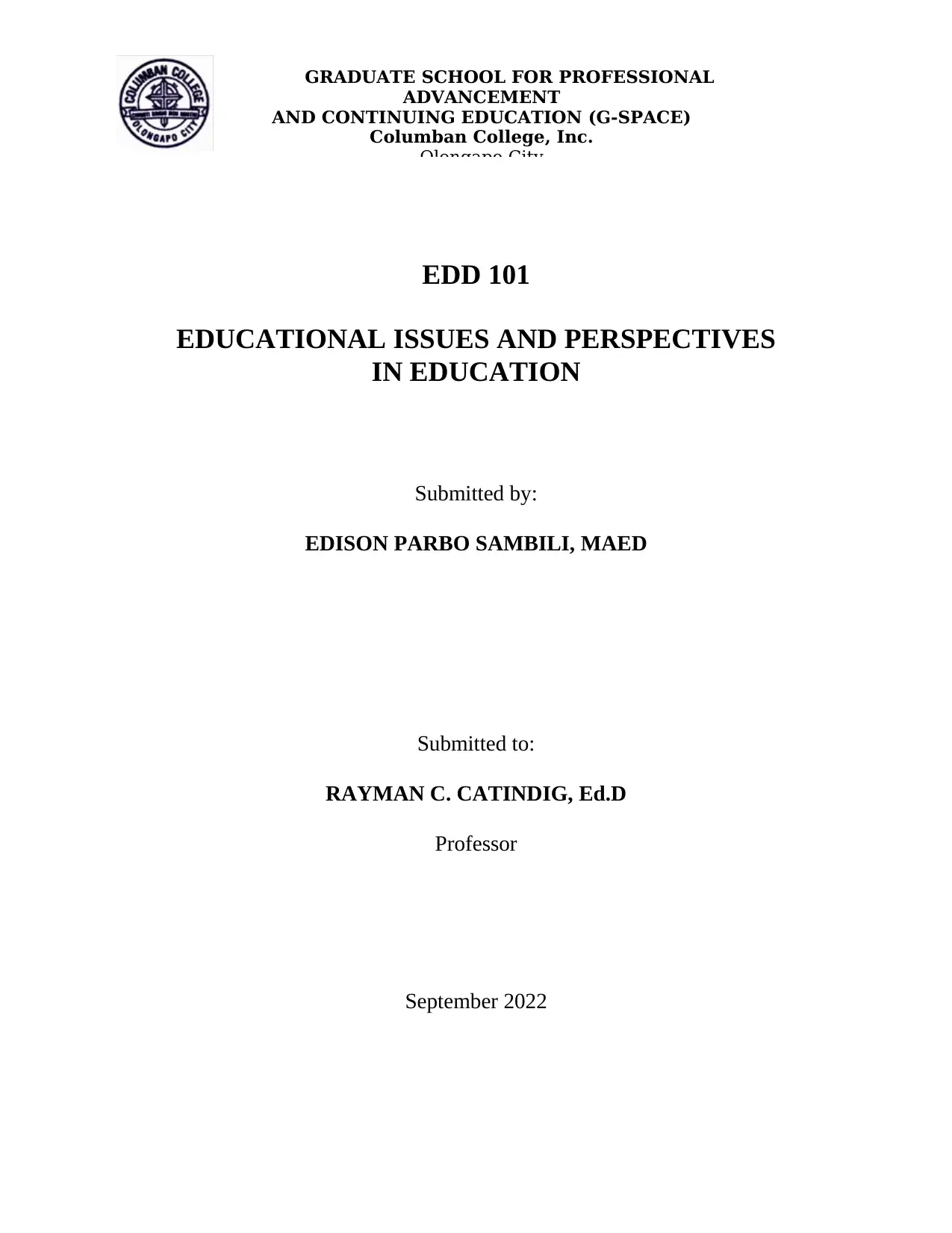
GRADUATE SCHOOL FOR PROFESSIONAL
ADVANCEMENT
AND CONTINUING EDUCATION (G-SPACE)
Columban College, Inc.
Olongapo City
EDD 101
EDUCATIONAL ISSUES AND PERSPECTIVES
IN EDUCATION
Submitted by:
EDISON PARBO SAMBILI, MAED
Submitted to:
RAYMAN C. CATINDIG, Ed.D
Professor
September 2022
ADVANCEMENT
AND CONTINUING EDUCATION (G-SPACE)
Columban College, Inc.
Olongapo City
EDD 101
EDUCATIONAL ISSUES AND PERSPECTIVES
IN EDUCATION
Submitted by:
EDISON PARBO SAMBILI, MAED
Submitted to:
RAYMAN C. CATINDIG, Ed.D
Professor
September 2022
Secure Best Marks with AI Grader
Need help grading? Try our AI Grader for instant feedback on your assignments.
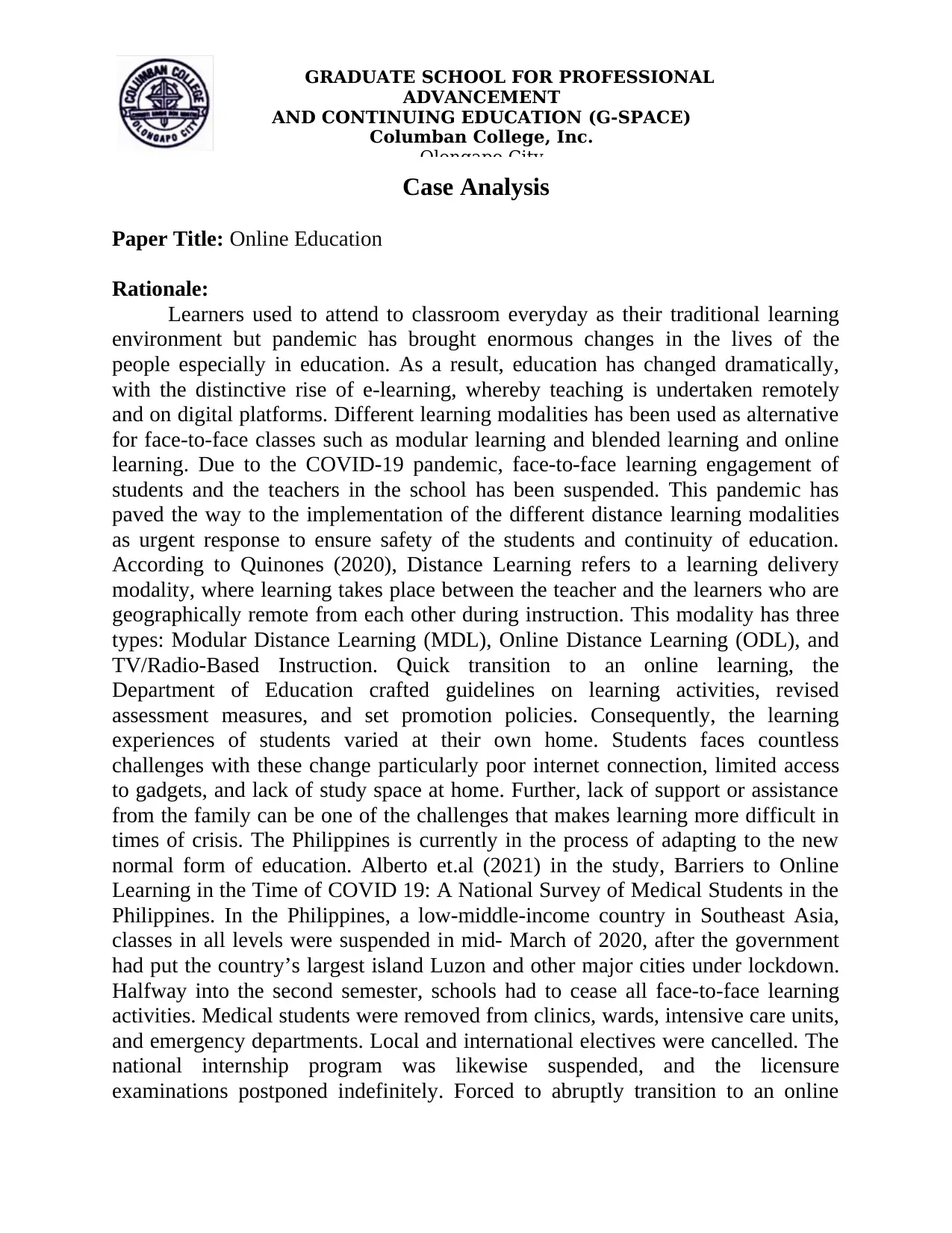
GRADUATE SCHOOL FOR PROFESSIONAL
ADVANCEMENT
AND CONTINUING EDUCATION (G-SPACE)
Columban College, Inc.
Olongapo City
Case Analysis
Paper Title: Online Education
Rationale:
Learners used to attend to classroom everyday as their traditional learning
environment but pandemic has brought enormous changes in the lives of the
people especially in education. As a result, education has changed dramatically,
with the distinctive rise of e-learning, whereby teaching is undertaken remotely
and on digital platforms. Different learning modalities has been used as alternative
for face-to-face classes such as modular learning and blended learning and online
learning. Due to the COVID-19 pandemic, face-to-face learning engagement of
students and the teachers in the school has been suspended. This pandemic has
paved the way to the implementation of the different distance learning modalities
as urgent response to ensure safety of the students and continuity of education.
According to Quinones (2020), Distance Learning refers to a learning delivery
modality, where learning takes place between the teacher and the learners who are
geographically remote from each other during instruction. This modality has three
types: Modular Distance Learning (MDL), Online Distance Learning (ODL), and
TV/Radio-Based Instruction. Quick transition to an online learning, the
Department of Education crafted guidelines on learning activities, revised
assessment measures, and set promotion policies. Consequently, the learning
experiences of students varied at their own home. Students faces countless
challenges with these change particularly poor internet connection, limited access
to gadgets, and lack of study space at home. Further, lack of support or assistance
from the family can be one of the challenges that makes learning more difficult in
times of crisis. The Philippines is currently in the process of adapting to the new
normal form of education. Alberto et.al (2021) in the study, Barriers to Online
Learning in the Time of COVID 19: A National Survey of Medical Students in the
Philippines. In the Philippines, a low-middle-income country in Southeast Asia,
classes in all levels were suspended in mid- March of 2020, after the government
had put the country’s largest island Luzon and other major cities under lockdown.
Halfway into the second semester, schools had to cease all face-to-face learning
activities. Medical students were removed from clinics, wards, intensive care units,
and emergency departments. Local and international electives were cancelled. The
national internship program was likewise suspended, and the licensure
examinations postponed indefinitely. Forced to abruptly transition to an online
ADVANCEMENT
AND CONTINUING EDUCATION (G-SPACE)
Columban College, Inc.
Olongapo City
Case Analysis
Paper Title: Online Education
Rationale:
Learners used to attend to classroom everyday as their traditional learning
environment but pandemic has brought enormous changes in the lives of the
people especially in education. As a result, education has changed dramatically,
with the distinctive rise of e-learning, whereby teaching is undertaken remotely
and on digital platforms. Different learning modalities has been used as alternative
for face-to-face classes such as modular learning and blended learning and online
learning. Due to the COVID-19 pandemic, face-to-face learning engagement of
students and the teachers in the school has been suspended. This pandemic has
paved the way to the implementation of the different distance learning modalities
as urgent response to ensure safety of the students and continuity of education.
According to Quinones (2020), Distance Learning refers to a learning delivery
modality, where learning takes place between the teacher and the learners who are
geographically remote from each other during instruction. This modality has three
types: Modular Distance Learning (MDL), Online Distance Learning (ODL), and
TV/Radio-Based Instruction. Quick transition to an online learning, the
Department of Education crafted guidelines on learning activities, revised
assessment measures, and set promotion policies. Consequently, the learning
experiences of students varied at their own home. Students faces countless
challenges with these change particularly poor internet connection, limited access
to gadgets, and lack of study space at home. Further, lack of support or assistance
from the family can be one of the challenges that makes learning more difficult in
times of crisis. The Philippines is currently in the process of adapting to the new
normal form of education. Alberto et.al (2021) in the study, Barriers to Online
Learning in the Time of COVID 19: A National Survey of Medical Students in the
Philippines. In the Philippines, a low-middle-income country in Southeast Asia,
classes in all levels were suspended in mid- March of 2020, after the government
had put the country’s largest island Luzon and other major cities under lockdown.
Halfway into the second semester, schools had to cease all face-to-face learning
activities. Medical students were removed from clinics, wards, intensive care units,
and emergency departments. Local and international electives were cancelled. The
national internship program was likewise suspended, and the licensure
examinations postponed indefinitely. Forced to abruptly transition to an online

GRADUATE SCHOOL FOR PROFESSIONAL
ADVANCEMENT
AND CONTINUING EDUCATION (G-SPACE)
Columban College, Inc.
Olongapo City
curriculum, each school crafted its own guidelines on learning activities, revised
assessment measures, and set promotion policies. According to Horn & Staker
(2013), online learning, where instruction is delivered primarily over the internet,
is leading the transformation of public education in the United States. Since online
schools began in the mid-90s, thousands of programs have been created, ranging
from small programs within a local school, to online schools, to state-wide
programs, multistate, and international programs. All of these online learning
programs can be categorized under the umbrella of distance education. In addition,
a growing cadre of schools are transforming teaching and learning through blended
learning. Horn and Staker define blended learning as “… any time a student learns,
at least in part, at a supervised brick-and-mortar location away from home and, at
least in part, through online delivery with some element of student control over
time, place, path, and/or pace. The modality along each student’s learning path
within a course or subject are connected to provide an integrated learning
experience” On the other hand, based on Petrulis (2020), in a journal “Access and
Equity in Online Learning,” The sudden shift to online learning can deepen
existing inequalities. The uneven distribution and access to technology combined
with the implications of a global pandemic for different socio-economic and racial
group’s means that many students will be disproportionately affected by the shift
to remote work. For instructors, this means that we need to think about logistical
and technological concerns as inseparable from pedagogical ones. Considering all
of the factors that may be affecting student performance also means curating an
inclusive pedagogy that prioritizes equitable access to the learning environment.
Moreover, he added that inclusive pedagogy asks us to consider how we can help
all students succeed. Facilitating inclusion in the physical classroom often means
creating spaces where students feel valued and included, setting clear expectations,
and making learning and assessment accessible to all students. Though the online
shift can complicate these strategies, the principles remain the same. Adapted to
online teaching contexts, inclusive teaching and learning requires transparency,
accessibility, and flexibility. A holistic approach to education –that addresses
students’ learning, social and emotional needs –is crucial, especially in times of
crisis. School closures related to the current COVID-19 pandemic mean that
students from diverse backgrounds who are more at risk of increased vulnerability
are less likely to receive the support and extra services they need, and the gap
between students that experience additional barriers and that do not might widen.
Closures can also have considerable effects on students’ sense of belonging to
schools and their feelings of self-worth –these are key for inclusion in education.
ADVANCEMENT
AND CONTINUING EDUCATION (G-SPACE)
Columban College, Inc.
Olongapo City
curriculum, each school crafted its own guidelines on learning activities, revised
assessment measures, and set promotion policies. According to Horn & Staker
(2013), online learning, where instruction is delivered primarily over the internet,
is leading the transformation of public education in the United States. Since online
schools began in the mid-90s, thousands of programs have been created, ranging
from small programs within a local school, to online schools, to state-wide
programs, multistate, and international programs. All of these online learning
programs can be categorized under the umbrella of distance education. In addition,
a growing cadre of schools are transforming teaching and learning through blended
learning. Horn and Staker define blended learning as “… any time a student learns,
at least in part, at a supervised brick-and-mortar location away from home and, at
least in part, through online delivery with some element of student control over
time, place, path, and/or pace. The modality along each student’s learning path
within a course or subject are connected to provide an integrated learning
experience” On the other hand, based on Petrulis (2020), in a journal “Access and
Equity in Online Learning,” The sudden shift to online learning can deepen
existing inequalities. The uneven distribution and access to technology combined
with the implications of a global pandemic for different socio-economic and racial
group’s means that many students will be disproportionately affected by the shift
to remote work. For instructors, this means that we need to think about logistical
and technological concerns as inseparable from pedagogical ones. Considering all
of the factors that may be affecting student performance also means curating an
inclusive pedagogy that prioritizes equitable access to the learning environment.
Moreover, he added that inclusive pedagogy asks us to consider how we can help
all students succeed. Facilitating inclusion in the physical classroom often means
creating spaces where students feel valued and included, setting clear expectations,
and making learning and assessment accessible to all students. Though the online
shift can complicate these strategies, the principles remain the same. Adapted to
online teaching contexts, inclusive teaching and learning requires transparency,
accessibility, and flexibility. A holistic approach to education –that addresses
students’ learning, social and emotional needs –is crucial, especially in times of
crisis. School closures related to the current COVID-19 pandemic mean that
students from diverse backgrounds who are more at risk of increased vulnerability
are less likely to receive the support and extra services they need, and the gap
between students that experience additional barriers and that do not might widen.
Closures can also have considerable effects on students’ sense of belonging to
schools and their feelings of self-worth –these are key for inclusion in education.
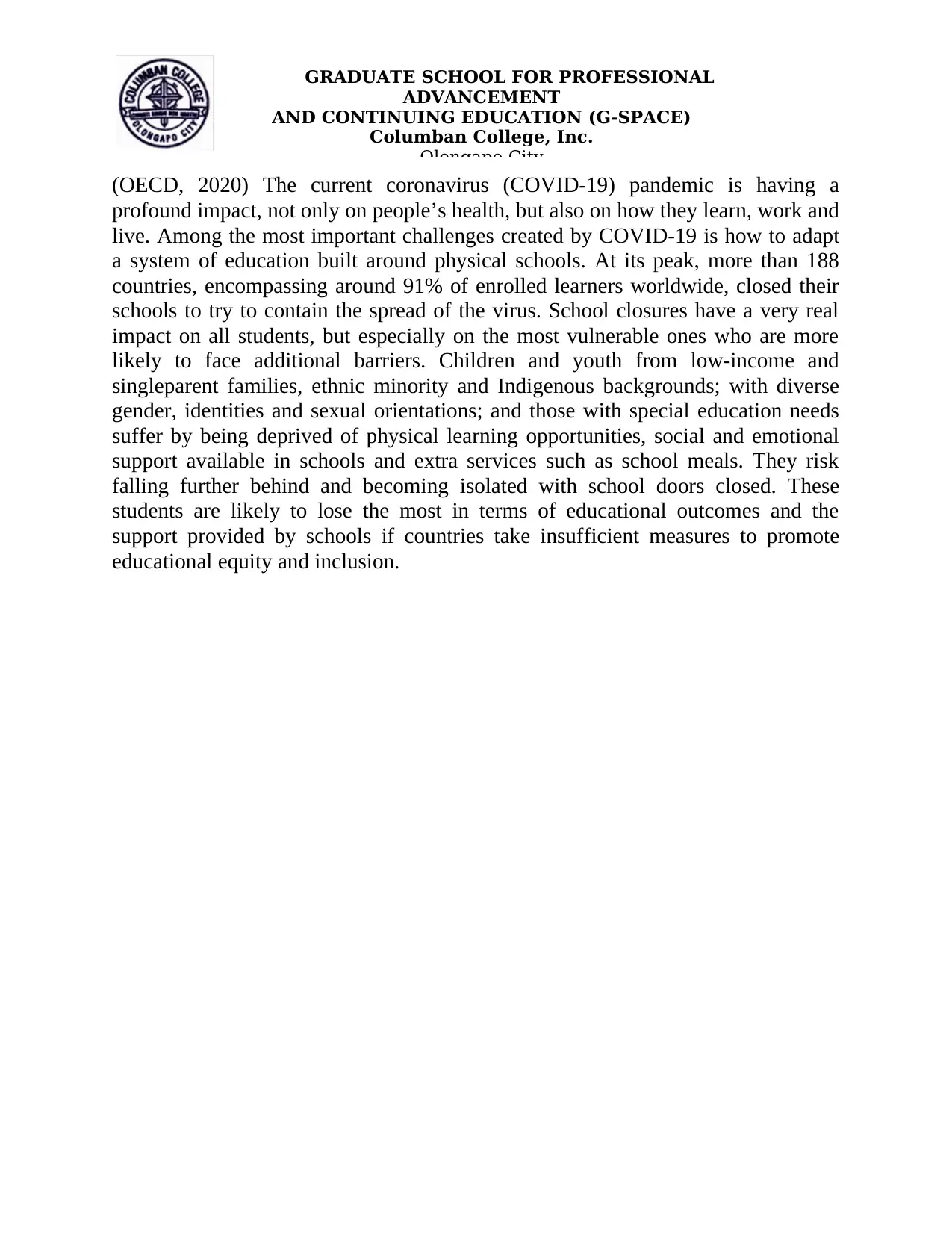
GRADUATE SCHOOL FOR PROFESSIONAL
ADVANCEMENT
AND CONTINUING EDUCATION (G-SPACE)
Columban College, Inc.
Olongapo City
(OECD, 2020) The current coronavirus (COVID-19) pandemic is having a
profound impact, not only on people’s health, but also on how they learn, work and
live. Among the most important challenges created by COVID-19 is how to adapt
a system of education built around physical schools. At its peak, more than 188
countries, encompassing around 91% of enrolled learners worldwide, closed their
schools to try to contain the spread of the virus. School closures have a very real
impact on all students, but especially on the most vulnerable ones who are more
likely to face additional barriers. Children and youth from low-income and
singleparent families, ethnic minority and Indigenous backgrounds; with diverse
gender, identities and sexual orientations; and those with special education needs
suffer by being deprived of physical learning opportunities, social and emotional
support available in schools and extra services such as school meals. They risk
falling further behind and becoming isolated with school doors closed. These
students are likely to lose the most in terms of educational outcomes and the
support provided by schools if countries take insufficient measures to promote
educational equity and inclusion.
ADVANCEMENT
AND CONTINUING EDUCATION (G-SPACE)
Columban College, Inc.
Olongapo City
(OECD, 2020) The current coronavirus (COVID-19) pandemic is having a
profound impact, not only on people’s health, but also on how they learn, work and
live. Among the most important challenges created by COVID-19 is how to adapt
a system of education built around physical schools. At its peak, more than 188
countries, encompassing around 91% of enrolled learners worldwide, closed their
schools to try to contain the spread of the virus. School closures have a very real
impact on all students, but especially on the most vulnerable ones who are more
likely to face additional barriers. Children and youth from low-income and
singleparent families, ethnic minority and Indigenous backgrounds; with diverse
gender, identities and sexual orientations; and those with special education needs
suffer by being deprived of physical learning opportunities, social and emotional
support available in schools and extra services such as school meals. They risk
falling further behind and becoming isolated with school doors closed. These
students are likely to lose the most in terms of educational outcomes and the
support provided by schools if countries take insufficient measures to promote
educational equity and inclusion.
Secure Best Marks with AI Grader
Need help grading? Try our AI Grader for instant feedback on your assignments.
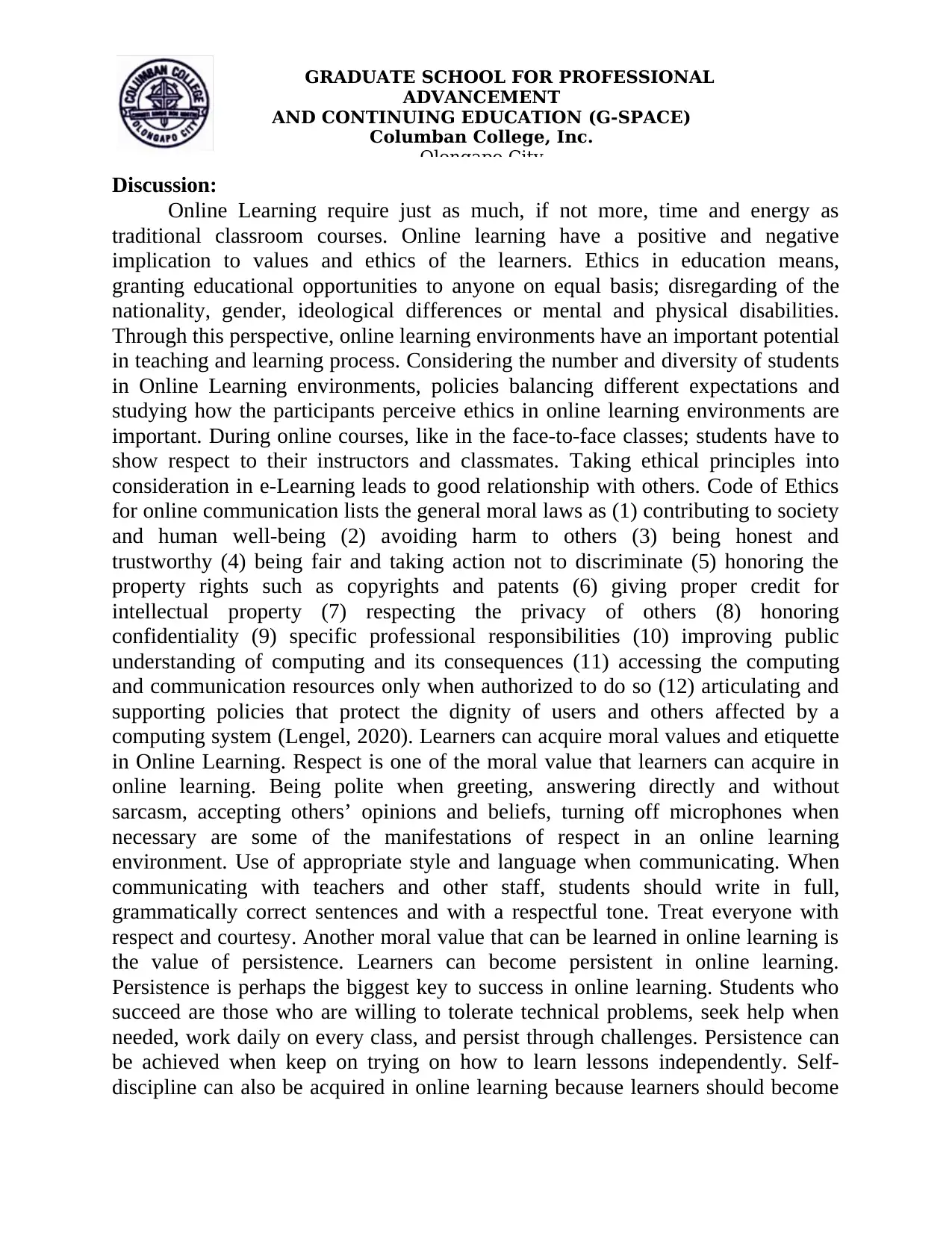
GRADUATE SCHOOL FOR PROFESSIONAL
ADVANCEMENT
AND CONTINUING EDUCATION (G-SPACE)
Columban College, Inc.
Olongapo City
Discussion:
Online Learning require just as much, if not more, time and energy as
traditional classroom courses. Online learning have a positive and negative
implication to values and ethics of the learners. Ethics in education means,
granting educational opportunities to anyone on equal basis; disregarding of the
nationality, gender, ideological differences or mental and physical disabilities.
Through this perspective, online learning environments have an important potential
in teaching and learning process. Considering the number and diversity of students
in Online Learning environments, policies balancing different expectations and
studying how the participants perceive ethics in online learning environments are
important. During online courses, like in the face-to-face classes; students have to
show respect to their instructors and classmates. Taking ethical principles into
consideration in e-Learning leads to good relationship with others. Code of Ethics
for online communication lists the general moral laws as (1) contributing to society
and human well-being (2) avoiding harm to others (3) being honest and
trustworthy (4) being fair and taking action not to discriminate (5) honoring the
property rights such as copyrights and patents (6) giving proper credit for
intellectual property (7) respecting the privacy of others (8) honoring
confidentiality (9) specific professional responsibilities (10) improving public
understanding of computing and its consequences (11) accessing the computing
and communication resources only when authorized to do so (12) articulating and
supporting policies that protect the dignity of users and others affected by a
computing system (Lengel, 2020). Learners can acquire moral values and etiquette
in Online Learning. Respect is one of the moral value that learners can acquire in
online learning. Being polite when greeting, answering directly and without
sarcasm, accepting others’ opinions and beliefs, turning off microphones when
necessary are some of the manifestations of respect in an online learning
environment. Use of appropriate style and language when communicating. When
communicating with teachers and other staff, students should write in full,
grammatically correct sentences and with a respectful tone. Treat everyone with
respect and courtesy. Another moral value that can be learned in online learning is
the value of persistence. Learners can become persistent in online learning.
Persistence is perhaps the biggest key to success in online learning. Students who
succeed are those who are willing to tolerate technical problems, seek help when
needed, work daily on every class, and persist through challenges. Persistence can
be achieved when keep on trying on how to learn lessons independently. Self-
discipline can also be acquired in online learning because learners should become
ADVANCEMENT
AND CONTINUING EDUCATION (G-SPACE)
Columban College, Inc.
Olongapo City
Discussion:
Online Learning require just as much, if not more, time and energy as
traditional classroom courses. Online learning have a positive and negative
implication to values and ethics of the learners. Ethics in education means,
granting educational opportunities to anyone on equal basis; disregarding of the
nationality, gender, ideological differences or mental and physical disabilities.
Through this perspective, online learning environments have an important potential
in teaching and learning process. Considering the number and diversity of students
in Online Learning environments, policies balancing different expectations and
studying how the participants perceive ethics in online learning environments are
important. During online courses, like in the face-to-face classes; students have to
show respect to their instructors and classmates. Taking ethical principles into
consideration in e-Learning leads to good relationship with others. Code of Ethics
for online communication lists the general moral laws as (1) contributing to society
and human well-being (2) avoiding harm to others (3) being honest and
trustworthy (4) being fair and taking action not to discriminate (5) honoring the
property rights such as copyrights and patents (6) giving proper credit for
intellectual property (7) respecting the privacy of others (8) honoring
confidentiality (9) specific professional responsibilities (10) improving public
understanding of computing and its consequences (11) accessing the computing
and communication resources only when authorized to do so (12) articulating and
supporting policies that protect the dignity of users and others affected by a
computing system (Lengel, 2020). Learners can acquire moral values and etiquette
in Online Learning. Respect is one of the moral value that learners can acquire in
online learning. Being polite when greeting, answering directly and without
sarcasm, accepting others’ opinions and beliefs, turning off microphones when
necessary are some of the manifestations of respect in an online learning
environment. Use of appropriate style and language when communicating. When
communicating with teachers and other staff, students should write in full,
grammatically correct sentences and with a respectful tone. Treat everyone with
respect and courtesy. Another moral value that can be learned in online learning is
the value of persistence. Learners can become persistent in online learning.
Persistence is perhaps the biggest key to success in online learning. Students who
succeed are those who are willing to tolerate technical problems, seek help when
needed, work daily on every class, and persist through challenges. Persistence can
be achieved when keep on trying on how to learn lessons independently. Self-
discipline can also be acquired in online learning because learners should become
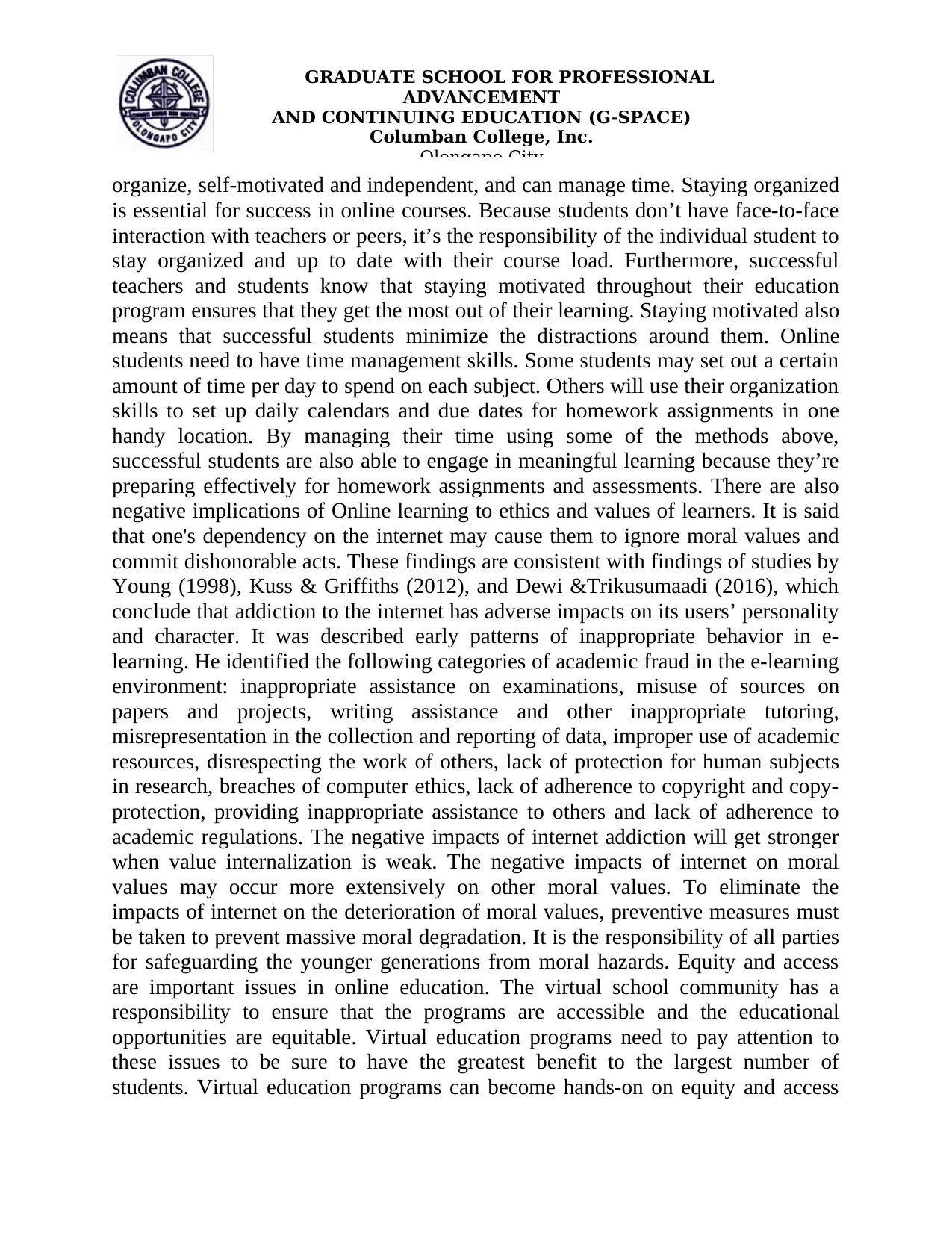
GRADUATE SCHOOL FOR PROFESSIONAL
ADVANCEMENT
AND CONTINUING EDUCATION (G-SPACE)
Columban College, Inc.
Olongapo City
organize, self-motivated and independent, and can manage time. Staying organized
is essential for success in online courses. Because students don’t have face-to-face
interaction with teachers or peers, it’s the responsibility of the individual student to
stay organized and up to date with their course load. Furthermore, successful
teachers and students know that staying motivated throughout their education
program ensures that they get the most out of their learning. Staying motivated also
means that successful students minimize the distractions around them. Online
students need to have time management skills. Some students may set out a certain
amount of time per day to spend on each subject. Others will use their organization
skills to set up daily calendars and due dates for homework assignments in one
handy location. By managing their time using some of the methods above,
successful students are also able to engage in meaningful learning because they’re
preparing effectively for homework assignments and assessments. There are also
negative implications of Online learning to ethics and values of learners. It is said
that one's dependency on the internet may cause them to ignore moral values and
commit dishonorable acts. These findings are consistent with findings of studies by
Young (1998), Kuss & Griffiths (2012), and Dewi &Trikusumaadi (2016), which
conclude that addiction to the internet has adverse impacts on its users’ personality
and character. It was described early patterns of inappropriate behavior in e-
learning. He identified the following categories of academic fraud in the e-learning
environment: inappropriate assistance on examinations, misuse of sources on
papers and projects, writing assistance and other inappropriate tutoring,
misrepresentation in the collection and reporting of data, improper use of academic
resources, disrespecting the work of others, lack of protection for human subjects
in research, breaches of computer ethics, lack of adherence to copyright and copy-
protection, providing inappropriate assistance to others and lack of adherence to
academic regulations. The negative impacts of internet addiction will get stronger
when value internalization is weak. The negative impacts of internet on moral
values may occur more extensively on other moral values. To eliminate the
impacts of internet on the deterioration of moral values, preventive measures must
be taken to prevent massive moral degradation. It is the responsibility of all parties
for safeguarding the younger generations from moral hazards. Equity and access
are important issues in online education. The virtual school community has a
responsibility to ensure that the programs are accessible and the educational
opportunities are equitable. Virtual education programs need to pay attention to
these issues to be sure to have the greatest benefit to the largest number of
students. Virtual education programs can become hands-on on equity and access
ADVANCEMENT
AND CONTINUING EDUCATION (G-SPACE)
Columban College, Inc.
Olongapo City
organize, self-motivated and independent, and can manage time. Staying organized
is essential for success in online courses. Because students don’t have face-to-face
interaction with teachers or peers, it’s the responsibility of the individual student to
stay organized and up to date with their course load. Furthermore, successful
teachers and students know that staying motivated throughout their education
program ensures that they get the most out of their learning. Staying motivated also
means that successful students minimize the distractions around them. Online
students need to have time management skills. Some students may set out a certain
amount of time per day to spend on each subject. Others will use their organization
skills to set up daily calendars and due dates for homework assignments in one
handy location. By managing their time using some of the methods above,
successful students are also able to engage in meaningful learning because they’re
preparing effectively for homework assignments and assessments. There are also
negative implications of Online learning to ethics and values of learners. It is said
that one's dependency on the internet may cause them to ignore moral values and
commit dishonorable acts. These findings are consistent with findings of studies by
Young (1998), Kuss & Griffiths (2012), and Dewi &Trikusumaadi (2016), which
conclude that addiction to the internet has adverse impacts on its users’ personality
and character. It was described early patterns of inappropriate behavior in e-
learning. He identified the following categories of academic fraud in the e-learning
environment: inappropriate assistance on examinations, misuse of sources on
papers and projects, writing assistance and other inappropriate tutoring,
misrepresentation in the collection and reporting of data, improper use of academic
resources, disrespecting the work of others, lack of protection for human subjects
in research, breaches of computer ethics, lack of adherence to copyright and copy-
protection, providing inappropriate assistance to others and lack of adherence to
academic regulations. The negative impacts of internet addiction will get stronger
when value internalization is weak. The negative impacts of internet on moral
values may occur more extensively on other moral values. To eliminate the
impacts of internet on the deterioration of moral values, preventive measures must
be taken to prevent massive moral degradation. It is the responsibility of all parties
for safeguarding the younger generations from moral hazards. Equity and access
are important issues in online education. The virtual school community has a
responsibility to ensure that the programs are accessible and the educational
opportunities are equitable. Virtual education programs need to pay attention to
these issues to be sure to have the greatest benefit to the largest number of
students. Virtual education programs can become hands-on on equity and access
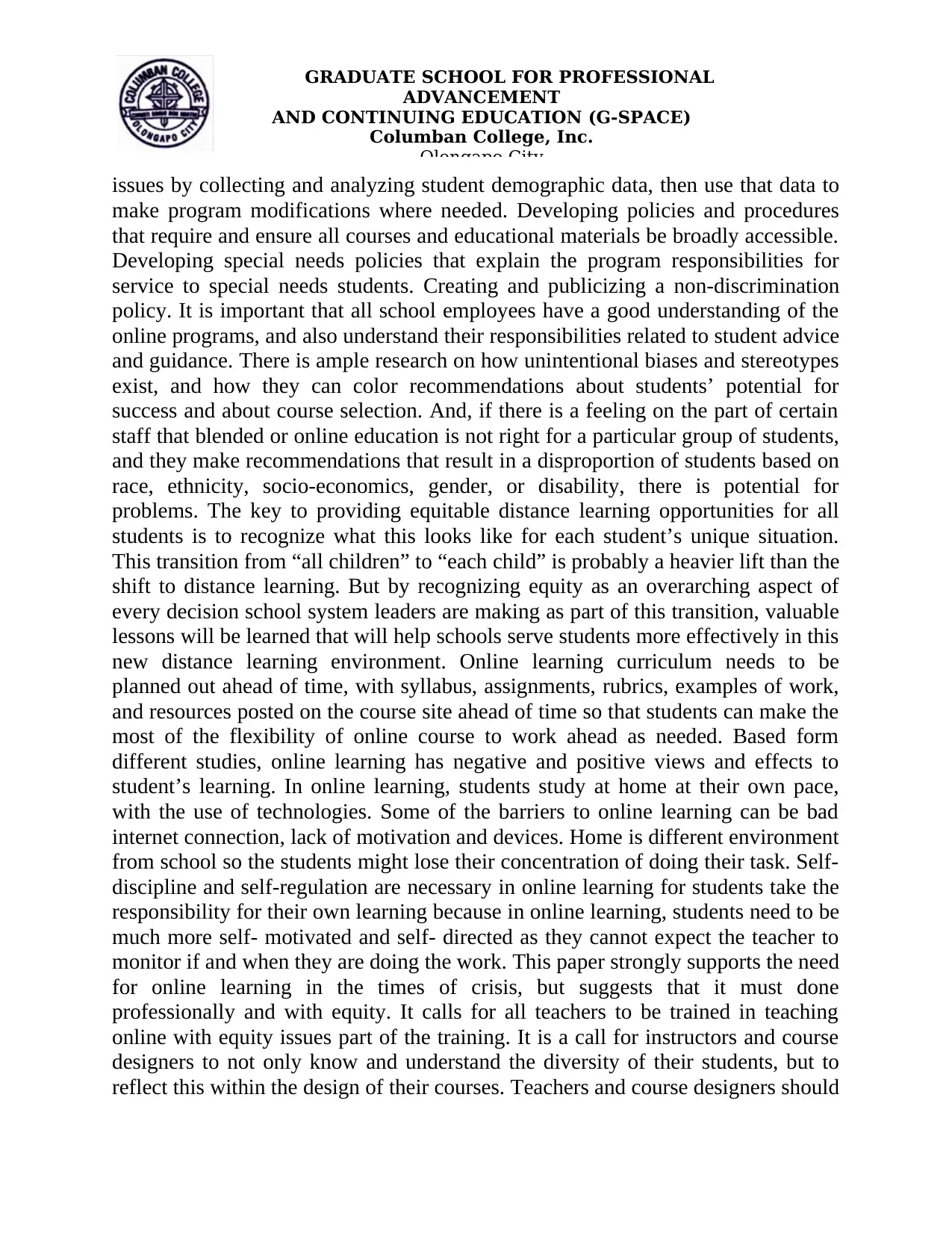
GRADUATE SCHOOL FOR PROFESSIONAL
ADVANCEMENT
AND CONTINUING EDUCATION (G-SPACE)
Columban College, Inc.
Olongapo City
issues by collecting and analyzing student demographic data, then use that data to
make program modifications where needed. Developing policies and procedures
that require and ensure all courses and educational materials be broadly accessible.
Developing special needs policies that explain the program responsibilities for
service to special needs students. Creating and publicizing a non-discrimination
policy. It is important that all school employees have a good understanding of the
online programs, and also understand their responsibilities related to student advice
and guidance. There is ample research on how unintentional biases and stereotypes
exist, and how they can color recommendations about students’ potential for
success and about course selection. And, if there is a feeling on the part of certain
staff that blended or online education is not right for a particular group of students,
and they make recommendations that result in a disproportion of students based on
race, ethnicity, socio-economics, gender, or disability, there is potential for
problems. The key to providing equitable distance learning opportunities for all
students is to recognize what this looks like for each student’s unique situation.
This transition from “all children” to “each child” is probably a heavier lift than the
shift to distance learning. But by recognizing equity as an overarching aspect of
every decision school system leaders are making as part of this transition, valuable
lessons will be learned that will help schools serve students more effectively in this
new distance learning environment. Online learning curriculum needs to be
planned out ahead of time, with syllabus, assignments, rubrics, examples of work,
and resources posted on the course site ahead of time so that students can make the
most of the flexibility of online course to work ahead as needed. Based form
different studies, online learning has negative and positive views and effects to
student’s learning. In online learning, students study at home at their own pace,
with the use of technologies. Some of the barriers to online learning can be bad
internet connection, lack of motivation and devices. Home is different environment
from school so the students might lose their concentration of doing their task. Self-
discipline and self-regulation are necessary in online learning for students take the
responsibility for their own learning because in online learning, students need to be
much more self- motivated and self- directed as they cannot expect the teacher to
monitor if and when they are doing the work. This paper strongly supports the need
for online learning in the times of crisis, but suggests that it must done
professionally and with equity. It calls for all teachers to be trained in teaching
online with equity issues part of the training. It is a call for instructors and course
designers to not only know and understand the diversity of their students, but to
reflect this within the design of their courses. Teachers and course designers should
ADVANCEMENT
AND CONTINUING EDUCATION (G-SPACE)
Columban College, Inc.
Olongapo City
issues by collecting and analyzing student demographic data, then use that data to
make program modifications where needed. Developing policies and procedures
that require and ensure all courses and educational materials be broadly accessible.
Developing special needs policies that explain the program responsibilities for
service to special needs students. Creating and publicizing a non-discrimination
policy. It is important that all school employees have a good understanding of the
online programs, and also understand their responsibilities related to student advice
and guidance. There is ample research on how unintentional biases and stereotypes
exist, and how they can color recommendations about students’ potential for
success and about course selection. And, if there is a feeling on the part of certain
staff that blended or online education is not right for a particular group of students,
and they make recommendations that result in a disproportion of students based on
race, ethnicity, socio-economics, gender, or disability, there is potential for
problems. The key to providing equitable distance learning opportunities for all
students is to recognize what this looks like for each student’s unique situation.
This transition from “all children” to “each child” is probably a heavier lift than the
shift to distance learning. But by recognizing equity as an overarching aspect of
every decision school system leaders are making as part of this transition, valuable
lessons will be learned that will help schools serve students more effectively in this
new distance learning environment. Online learning curriculum needs to be
planned out ahead of time, with syllabus, assignments, rubrics, examples of work,
and resources posted on the course site ahead of time so that students can make the
most of the flexibility of online course to work ahead as needed. Based form
different studies, online learning has negative and positive views and effects to
student’s learning. In online learning, students study at home at their own pace,
with the use of technologies. Some of the barriers to online learning can be bad
internet connection, lack of motivation and devices. Home is different environment
from school so the students might lose their concentration of doing their task. Self-
discipline and self-regulation are necessary in online learning for students take the
responsibility for their own learning because in online learning, students need to be
much more self- motivated and self- directed as they cannot expect the teacher to
monitor if and when they are doing the work. This paper strongly supports the need
for online learning in the times of crisis, but suggests that it must done
professionally and with equity. It calls for all teachers to be trained in teaching
online with equity issues part of the training. It is a call for instructors and course
designers to not only know and understand the diversity of their students, but to
reflect this within the design of their courses. Teachers and course designers should
Paraphrase This Document
Need a fresh take? Get an instant paraphrase of this document with our AI Paraphraser
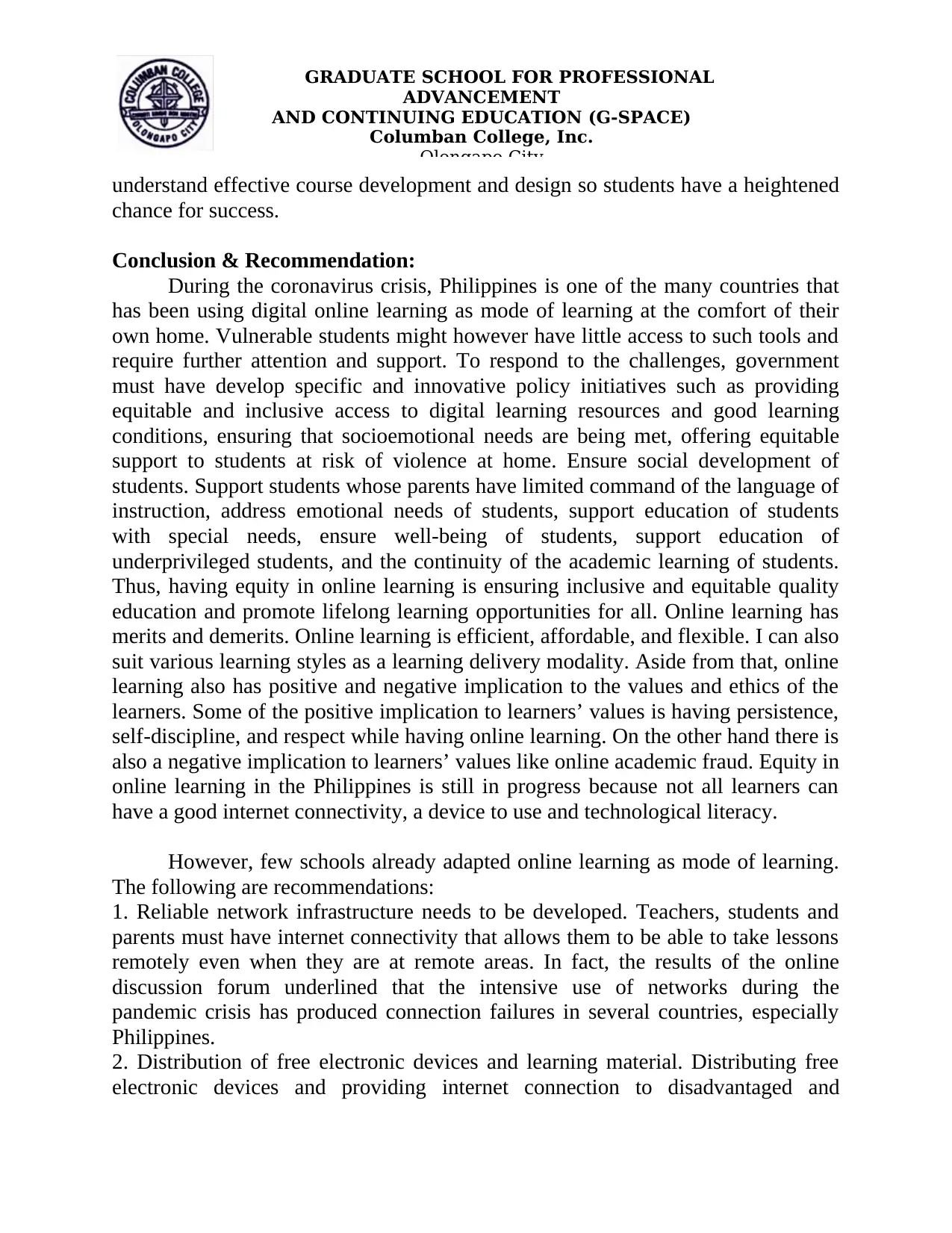
GRADUATE SCHOOL FOR PROFESSIONAL
ADVANCEMENT
AND CONTINUING EDUCATION (G-SPACE)
Columban College, Inc.
Olongapo City
understand effective course development and design so students have a heightened
chance for success.
Conclusion & Recommendation:
During the coronavirus crisis, Philippines is one of the many countries that
has been using digital online learning as mode of learning at the comfort of their
own home. Vulnerable students might however have little access to such tools and
require further attention and support. To respond to the challenges, government
must have develop specific and innovative policy initiatives such as providing
equitable and inclusive access to digital learning resources and good learning
conditions, ensuring that socioemotional needs are being met, offering equitable
support to students at risk of violence at home. Ensure social development of
students. Support students whose parents have limited command of the language of
instruction, address emotional needs of students, support education of students
with special needs, ensure well-being of students, support education of
underprivileged students, and the continuity of the academic learning of students.
Thus, having equity in online learning is ensuring inclusive and equitable quality
education and promote lifelong learning opportunities for all. Online learning has
merits and demerits. Online learning is efficient, affordable, and flexible. I can also
suit various learning styles as a learning delivery modality. Aside from that, online
learning also has positive and negative implication to the values and ethics of the
learners. Some of the positive implication to learners’ values is having persistence,
self-discipline, and respect while having online learning. On the other hand there is
also a negative implication to learners’ values like online academic fraud. Equity in
online learning in the Philippines is still in progress because not all learners can
have a good internet connectivity, a device to use and technological literacy.
However, few schools already adapted online learning as mode of learning.
The following are recommendations:
1. Reliable network infrastructure needs to be developed. Teachers, students and
parents must have internet connectivity that allows them to be able to take lessons
remotely even when they are at remote areas. In fact, the results of the online
discussion forum underlined that the intensive use of networks during the
pandemic crisis has produced connection failures in several countries, especially
Philippines.
2. Distribution of free electronic devices and learning material. Distributing free
electronic devices and providing internet connection to disadvantaged and
ADVANCEMENT
AND CONTINUING EDUCATION (G-SPACE)
Columban College, Inc.
Olongapo City
understand effective course development and design so students have a heightened
chance for success.
Conclusion & Recommendation:
During the coronavirus crisis, Philippines is one of the many countries that
has been using digital online learning as mode of learning at the comfort of their
own home. Vulnerable students might however have little access to such tools and
require further attention and support. To respond to the challenges, government
must have develop specific and innovative policy initiatives such as providing
equitable and inclusive access to digital learning resources and good learning
conditions, ensuring that socioemotional needs are being met, offering equitable
support to students at risk of violence at home. Ensure social development of
students. Support students whose parents have limited command of the language of
instruction, address emotional needs of students, support education of students
with special needs, ensure well-being of students, support education of
underprivileged students, and the continuity of the academic learning of students.
Thus, having equity in online learning is ensuring inclusive and equitable quality
education and promote lifelong learning opportunities for all. Online learning has
merits and demerits. Online learning is efficient, affordable, and flexible. I can also
suit various learning styles as a learning delivery modality. Aside from that, online
learning also has positive and negative implication to the values and ethics of the
learners. Some of the positive implication to learners’ values is having persistence,
self-discipline, and respect while having online learning. On the other hand there is
also a negative implication to learners’ values like online academic fraud. Equity in
online learning in the Philippines is still in progress because not all learners can
have a good internet connectivity, a device to use and technological literacy.
However, few schools already adapted online learning as mode of learning.
The following are recommendations:
1. Reliable network infrastructure needs to be developed. Teachers, students and
parents must have internet connectivity that allows them to be able to take lessons
remotely even when they are at remote areas. In fact, the results of the online
discussion forum underlined that the intensive use of networks during the
pandemic crisis has produced connection failures in several countries, especially
Philippines.
2. Distribution of free electronic devices and learning material. Distributing free
electronic devices and providing internet connection to disadvantaged and
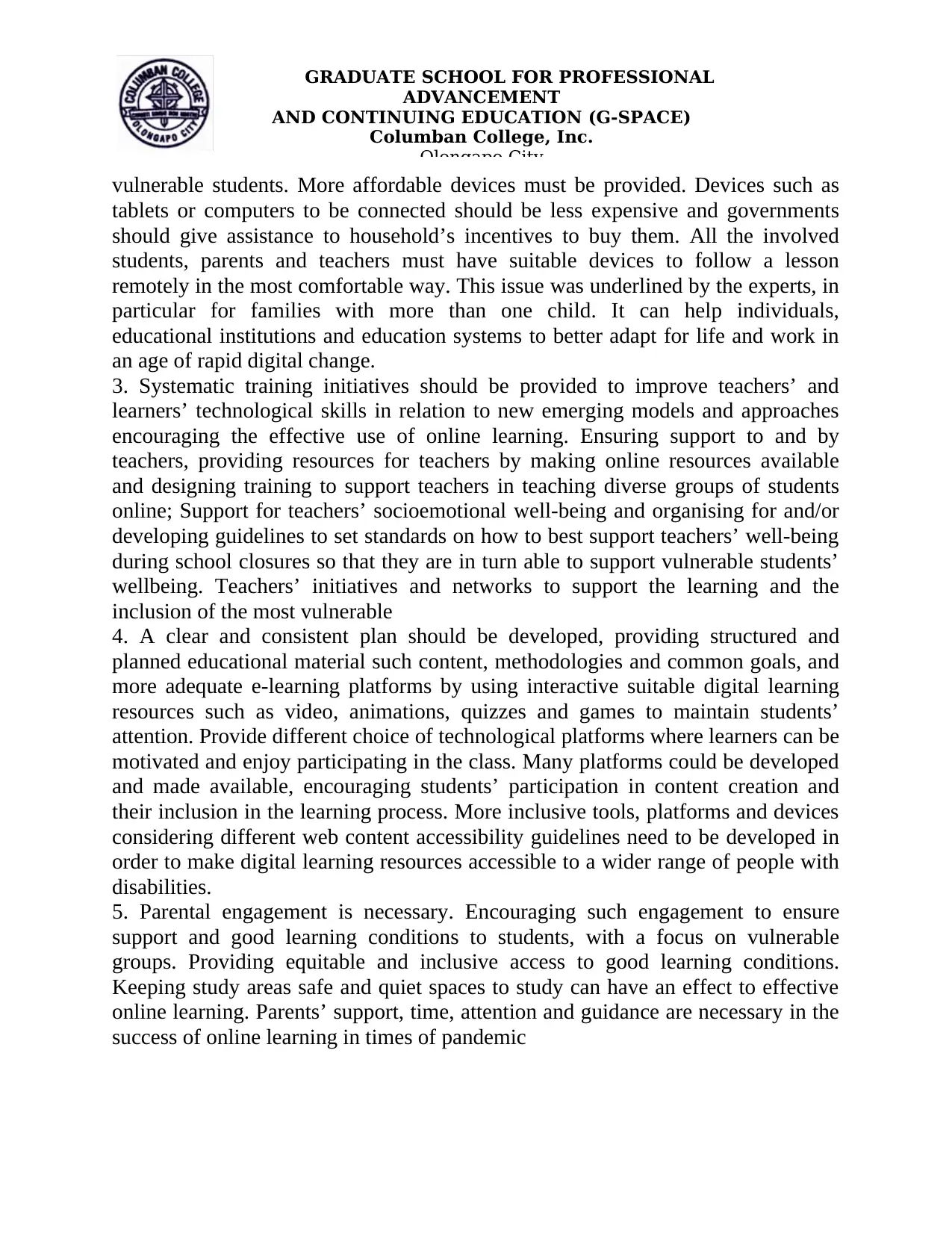
GRADUATE SCHOOL FOR PROFESSIONAL
ADVANCEMENT
AND CONTINUING EDUCATION (G-SPACE)
Columban College, Inc.
Olongapo City
vulnerable students. More affordable devices must be provided. Devices such as
tablets or computers to be connected should be less expensive and governments
should give assistance to household’s incentives to buy them. All the involved
students, parents and teachers must have suitable devices to follow a lesson
remotely in the most comfortable way. This issue was underlined by the experts, in
particular for families with more than one child. It can help individuals,
educational institutions and education systems to better adapt for life and work in
an age of rapid digital change.
3. Systematic training initiatives should be provided to improve teachers’ and
learners’ technological skills in relation to new emerging models and approaches
encouraging the effective use of online learning. Ensuring support to and by
teachers, providing resources for teachers by making online resources available
and designing training to support teachers in teaching diverse groups of students
online; Support for teachers’ socioemotional well-being and organising for and/or
developing guidelines to set standards on how to best support teachers’ well-being
during school closures so that they are in turn able to support vulnerable students’
wellbeing. Teachers’ initiatives and networks to support the learning and the
inclusion of the most vulnerable
4. A clear and consistent plan should be developed, providing structured and
planned educational material such content, methodologies and common goals, and
more adequate e-learning platforms by using interactive suitable digital learning
resources such as video, animations, quizzes and games to maintain students’
attention. Provide different choice of technological platforms where learners can be
motivated and enjoy participating in the class. Many platforms could be developed
and made available, encouraging students’ participation in content creation and
their inclusion in the learning process. More inclusive tools, platforms and devices
considering different web content accessibility guidelines need to be developed in
order to make digital learning resources accessible to a wider range of people with
disabilities.
5. Parental engagement is necessary. Encouraging such engagement to ensure
support and good learning conditions to students, with a focus on vulnerable
groups. Providing equitable and inclusive access to good learning conditions.
Keeping study areas safe and quiet spaces to study can have an effect to effective
online learning. Parents’ support, time, attention and guidance are necessary in the
success of online learning in times of pandemic
ADVANCEMENT
AND CONTINUING EDUCATION (G-SPACE)
Columban College, Inc.
Olongapo City
vulnerable students. More affordable devices must be provided. Devices such as
tablets or computers to be connected should be less expensive and governments
should give assistance to household’s incentives to buy them. All the involved
students, parents and teachers must have suitable devices to follow a lesson
remotely in the most comfortable way. This issue was underlined by the experts, in
particular for families with more than one child. It can help individuals,
educational institutions and education systems to better adapt for life and work in
an age of rapid digital change.
3. Systematic training initiatives should be provided to improve teachers’ and
learners’ technological skills in relation to new emerging models and approaches
encouraging the effective use of online learning. Ensuring support to and by
teachers, providing resources for teachers by making online resources available
and designing training to support teachers in teaching diverse groups of students
online; Support for teachers’ socioemotional well-being and organising for and/or
developing guidelines to set standards on how to best support teachers’ well-being
during school closures so that they are in turn able to support vulnerable students’
wellbeing. Teachers’ initiatives and networks to support the learning and the
inclusion of the most vulnerable
4. A clear and consistent plan should be developed, providing structured and
planned educational material such content, methodologies and common goals, and
more adequate e-learning platforms by using interactive suitable digital learning
resources such as video, animations, quizzes and games to maintain students’
attention. Provide different choice of technological platforms where learners can be
motivated and enjoy participating in the class. Many platforms could be developed
and made available, encouraging students’ participation in content creation and
their inclusion in the learning process. More inclusive tools, platforms and devices
considering different web content accessibility guidelines need to be developed in
order to make digital learning resources accessible to a wider range of people with
disabilities.
5. Parental engagement is necessary. Encouraging such engagement to ensure
support and good learning conditions to students, with a focus on vulnerable
groups. Providing equitable and inclusive access to good learning conditions.
Keeping study areas safe and quiet spaces to study can have an effect to effective
online learning. Parents’ support, time, attention and guidance are necessary in the
success of online learning in times of pandemic
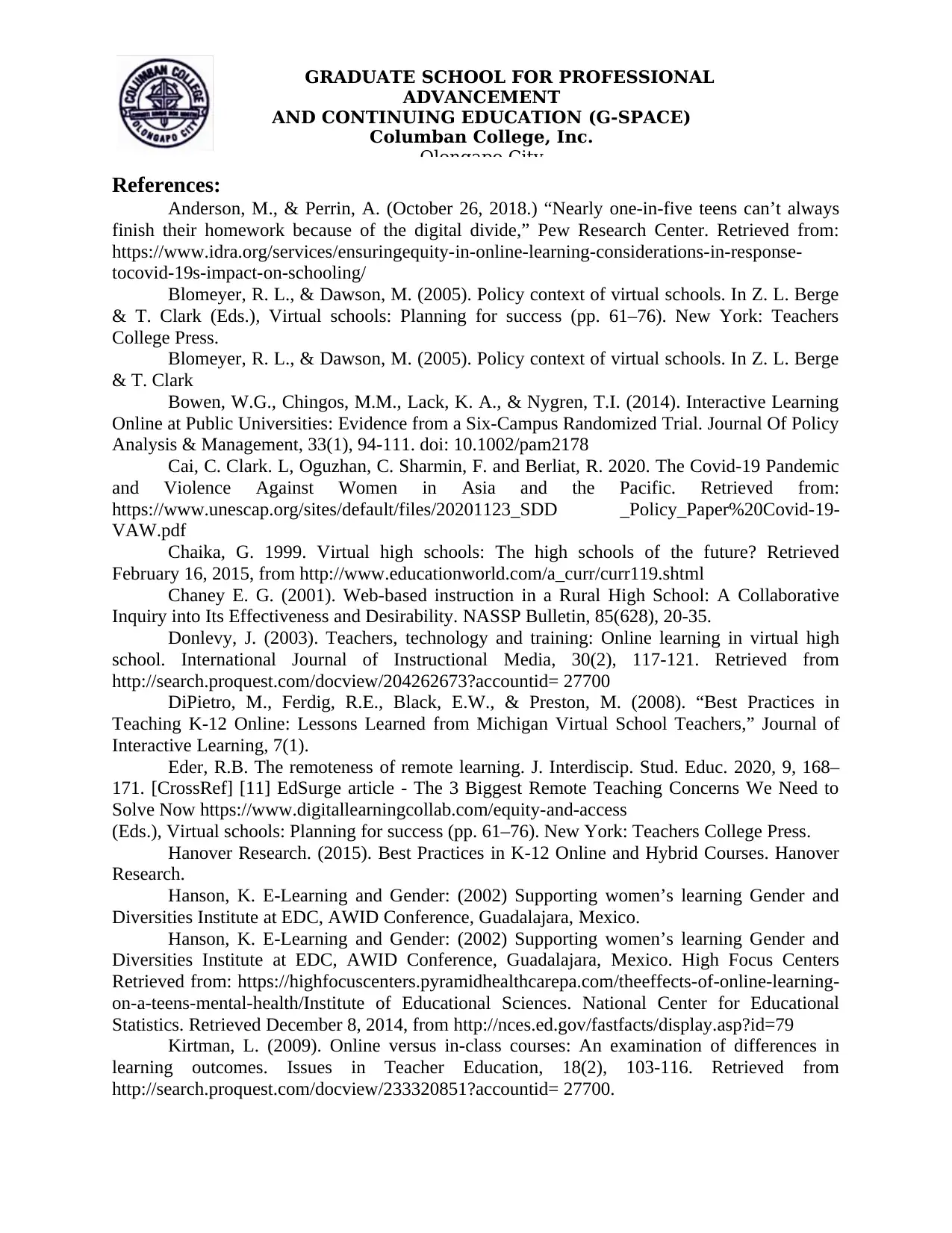
GRADUATE SCHOOL FOR PROFESSIONAL
ADVANCEMENT
AND CONTINUING EDUCATION (G-SPACE)
Columban College, Inc.
Olongapo City
References:
Anderson, M., & Perrin, A. (October 26, 2018.) “Nearly one-in-five teens can’t always
finish their homework because of the digital divide,” Pew Research Center. Retrieved from:
https://www.idra.org/services/ensuringequity-in-online-learning-considerations-in-response-
tocovid-19s-impact-on-schooling/
Blomeyer, R. L., & Dawson, M. (2005). Policy context of virtual schools. In Z. L. Berge
& T. Clark (Eds.), Virtual schools: Planning for success (pp. 61–76). New York: Teachers
College Press.
Blomeyer, R. L., & Dawson, M. (2005). Policy context of virtual schools. In Z. L. Berge
& T. Clark
Bowen, W.G., Chingos, M.M., Lack, K. A., & Nygren, T.I. (2014). Interactive Learning
Online at Public Universities: Evidence from a Six-Campus Randomized Trial. Journal Of Policy
Analysis & Management, 33(1), 94-111. doi: 10.1002/pam2178
Cai, C. Clark. L, Oguzhan, C. Sharmin, F. and Berliat, R. 2020. The Covid-19 Pandemic
and Violence Against Women in Asia and the Pacific. Retrieved from:
https://www.unescap.org/sites/default/files/20201123_SDD _Policy_Paper%20Covid-19-
VAW.pdf
Chaika, G. 1999. Virtual high schools: The high schools of the future? Retrieved
February 16, 2015, from http://www.educationworld.com/a_curr/curr119.shtml
Chaney E. G. (2001). Web-based instruction in a Rural High School: A Collaborative
Inquiry into Its Effectiveness and Desirability. NASSP Bulletin, 85(628), 20-35.
Donlevy, J. (2003). Teachers, technology and training: Online learning in virtual high
school. International Journal of Instructional Media, 30(2), 117-121. Retrieved from
http://search.proquest.com/docview/204262673?accountid= 27700
DiPietro, M., Ferdig, R.E., Black, E.W., & Preston, M. (2008). “Best Practices in
Teaching K-12 Online: Lessons Learned from Michigan Virtual School Teachers,” Journal of
Interactive Learning, 7(1).
Eder, R.B. The remoteness of remote learning. J. Interdiscip. Stud. Educ. 2020, 9, 168–
171. [CrossRef] [11] EdSurge article - The 3 Biggest Remote Teaching Concerns We Need to
Solve Now https://www.digitallearningcollab.com/equity-and-access
(Eds.), Virtual schools: Planning for success (pp. 61–76). New York: Teachers College Press.
Hanover Research. (2015). Best Practices in K-12 Online and Hybrid Courses. Hanover
Research.
Hanson, K. E-Learning and Gender: (2002) Supporting women’s learning Gender and
Diversities Institute at EDC, AWID Conference, Guadalajara, Mexico.
Hanson, K. E-Learning and Gender: (2002) Supporting women’s learning Gender and
Diversities Institute at EDC, AWID Conference, Guadalajara, Mexico. High Focus Centers
Retrieved from: https://highfocuscenters.pyramidhealthcarepa.com/theeffects-of-online-learning-
on-a-teens-mental-health/Institute of Educational Sciences. National Center for Educational
Statistics. Retrieved December 8, 2014, from http://nces.ed.gov/fastfacts/display.asp?id=79
Kirtman, L. (2009). Online versus in-class courses: An examination of differences in
learning outcomes. Issues in Teacher Education, 18(2), 103-116. Retrieved from
http://search.proquest.com/docview/233320851?accountid= 27700.
ADVANCEMENT
AND CONTINUING EDUCATION (G-SPACE)
Columban College, Inc.
Olongapo City
References:
Anderson, M., & Perrin, A. (October 26, 2018.) “Nearly one-in-five teens can’t always
finish their homework because of the digital divide,” Pew Research Center. Retrieved from:
https://www.idra.org/services/ensuringequity-in-online-learning-considerations-in-response-
tocovid-19s-impact-on-schooling/
Blomeyer, R. L., & Dawson, M. (2005). Policy context of virtual schools. In Z. L. Berge
& T. Clark (Eds.), Virtual schools: Planning for success (pp. 61–76). New York: Teachers
College Press.
Blomeyer, R. L., & Dawson, M. (2005). Policy context of virtual schools. In Z. L. Berge
& T. Clark
Bowen, W.G., Chingos, M.M., Lack, K. A., & Nygren, T.I. (2014). Interactive Learning
Online at Public Universities: Evidence from a Six-Campus Randomized Trial. Journal Of Policy
Analysis & Management, 33(1), 94-111. doi: 10.1002/pam2178
Cai, C. Clark. L, Oguzhan, C. Sharmin, F. and Berliat, R. 2020. The Covid-19 Pandemic
and Violence Against Women in Asia and the Pacific. Retrieved from:
https://www.unescap.org/sites/default/files/20201123_SDD _Policy_Paper%20Covid-19-
VAW.pdf
Chaika, G. 1999. Virtual high schools: The high schools of the future? Retrieved
February 16, 2015, from http://www.educationworld.com/a_curr/curr119.shtml
Chaney E. G. (2001). Web-based instruction in a Rural High School: A Collaborative
Inquiry into Its Effectiveness and Desirability. NASSP Bulletin, 85(628), 20-35.
Donlevy, J. (2003). Teachers, technology and training: Online learning in virtual high
school. International Journal of Instructional Media, 30(2), 117-121. Retrieved from
http://search.proquest.com/docview/204262673?accountid= 27700
DiPietro, M., Ferdig, R.E., Black, E.W., & Preston, M. (2008). “Best Practices in
Teaching K-12 Online: Lessons Learned from Michigan Virtual School Teachers,” Journal of
Interactive Learning, 7(1).
Eder, R.B. The remoteness of remote learning. J. Interdiscip. Stud. Educ. 2020, 9, 168–
171. [CrossRef] [11] EdSurge article - The 3 Biggest Remote Teaching Concerns We Need to
Solve Now https://www.digitallearningcollab.com/equity-and-access
(Eds.), Virtual schools: Planning for success (pp. 61–76). New York: Teachers College Press.
Hanover Research. (2015). Best Practices in K-12 Online and Hybrid Courses. Hanover
Research.
Hanson, K. E-Learning and Gender: (2002) Supporting women’s learning Gender and
Diversities Institute at EDC, AWID Conference, Guadalajara, Mexico.
Hanson, K. E-Learning and Gender: (2002) Supporting women’s learning Gender and
Diversities Institute at EDC, AWID Conference, Guadalajara, Mexico. High Focus Centers
Retrieved from: https://highfocuscenters.pyramidhealthcarepa.com/theeffects-of-online-learning-
on-a-teens-mental-health/Institute of Educational Sciences. National Center for Educational
Statistics. Retrieved December 8, 2014, from http://nces.ed.gov/fastfacts/display.asp?id=79
Kirtman, L. (2009). Online versus in-class courses: An examination of differences in
learning outcomes. Issues in Teacher Education, 18(2), 103-116. Retrieved from
http://search.proquest.com/docview/233320851?accountid= 27700.
Secure Best Marks with AI Grader
Need help grading? Try our AI Grader for instant feedback on your assignments.
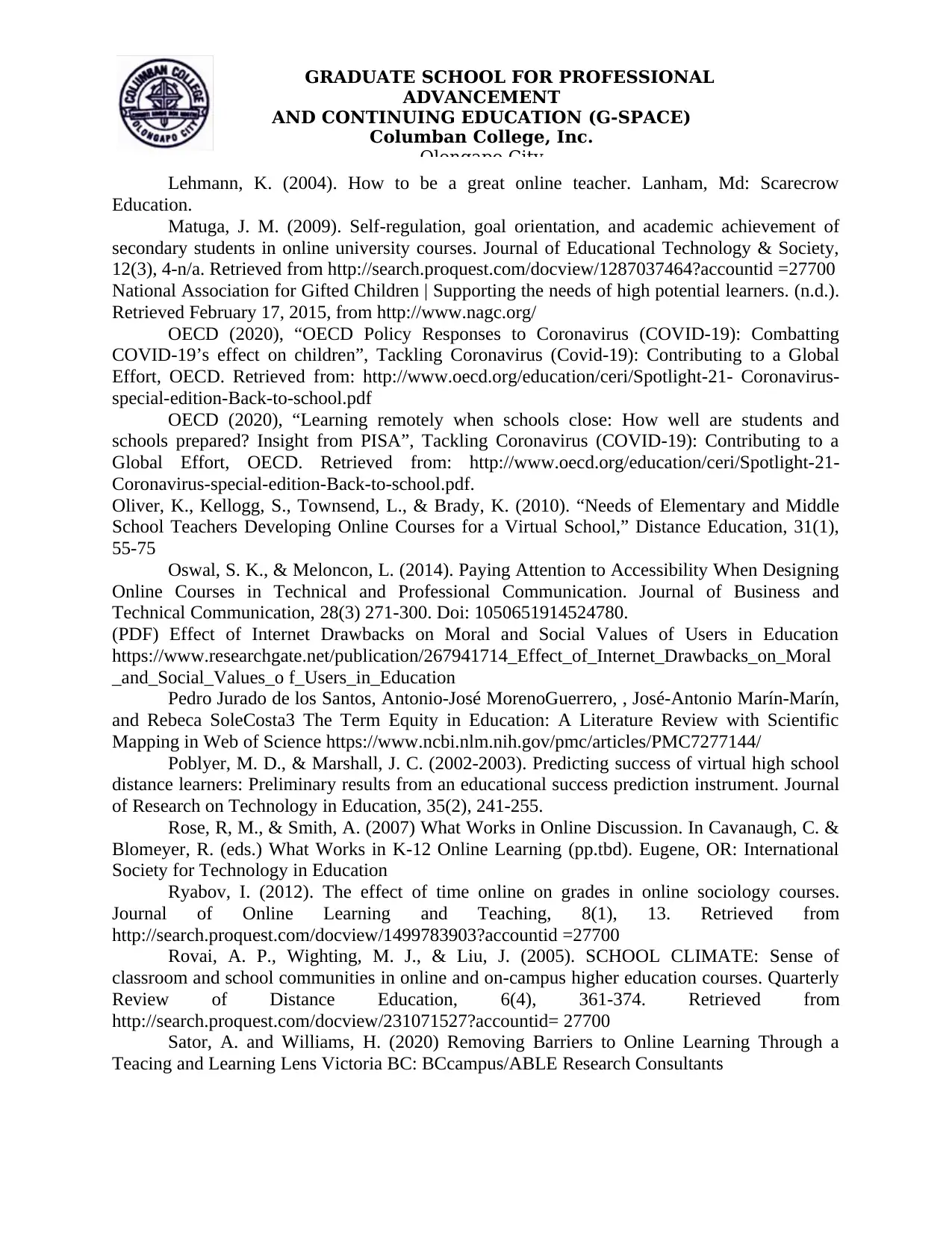
GRADUATE SCHOOL FOR PROFESSIONAL
ADVANCEMENT
AND CONTINUING EDUCATION (G-SPACE)
Columban College, Inc.
Olongapo City
Lehmann, K. (2004). How to be a great online teacher. Lanham, Md: Scarecrow
Education.
Matuga, J. M. (2009). Self-regulation, goal orientation, and academic achievement of
secondary students in online university courses. Journal of Educational Technology & Society,
12(3), 4-n/a. Retrieved from http://search.proquest.com/docview/1287037464?accountid =27700
National Association for Gifted Children | Supporting the needs of high potential learners. (n.d.).
Retrieved February 17, 2015, from http://www.nagc.org/
OECD (2020), “OECD Policy Responses to Coronavirus (COVID-19): Combatting
COVID-19’s effect on children”, Tackling Coronavirus (Covid-19): Contributing to a Global
Effort, OECD. Retrieved from: http://www.oecd.org/education/ceri/Spotlight-21- Coronavirus-
special-edition-Back-to-school.pdf
OECD (2020), “Learning remotely when schools close: How well are students and
schools prepared? Insight from PISA”, Tackling Coronavirus (COVID-19): Contributing to a
Global Effort, OECD. Retrieved from: http://www.oecd.org/education/ceri/Spotlight-21-
Coronavirus-special-edition-Back-to-school.pdf.
Oliver, K., Kellogg, S., Townsend, L., & Brady, K. (2010). “Needs of Elementary and Middle
School Teachers Developing Online Courses for a Virtual School,” Distance Education, 31(1),
55-75
Oswal, S. K., & Meloncon, L. (2014). Paying Attention to Accessibility When Designing
Online Courses in Technical and Professional Communication. Journal of Business and
Technical Communication, 28(3) 271-300. Doi: 1050651914524780.
(PDF) Effect of Internet Drawbacks on Moral and Social Values of Users in Education
https://www.researchgate.net/publication/267941714_Effect_of_Internet_Drawbacks_on_Moral
_and_Social_Values_o f_Users_in_Education
Pedro Jurado de los Santos, Antonio-José MorenoGuerrero, , José-Antonio Marín-Marín,
and Rebeca SoleCosta3 The Term Equity in Education: A Literature Review with Scientific
Mapping in Web of Science https://www.ncbi.nlm.nih.gov/pmc/articles/PMC7277144/
Poblyer, M. D., & Marshall, J. C. (2002-2003). Predicting success of virtual high school
distance learners: Preliminary results from an educational success prediction instrument. Journal
of Research on Technology in Education, 35(2), 241-255.
Rose, R, M., & Smith, A. (2007) What Works in Online Discussion. In Cavanaugh, C. &
Blomeyer, R. (eds.) What Works in K-12 Online Learning (pp.tbd). Eugene, OR: International
Society for Technology in Education
Ryabov, I. (2012). The effect of time online on grades in online sociology courses.
Journal of Online Learning and Teaching, 8(1), 13. Retrieved from
http://search.proquest.com/docview/1499783903?accountid =27700
Rovai, A. P., Wighting, M. J., & Liu, J. (2005). SCHOOL CLIMATE: Sense of
classroom and school communities in online and on-campus higher education courses. Quarterly
Review of Distance Education, 6(4), 361-374. Retrieved from
http://search.proquest.com/docview/231071527?accountid= 27700
Sator, A. and Williams, H. (2020) Removing Barriers to Online Learning Through a
Teacing and Learning Lens Victoria BC: BCcampus/ABLE Research Consultants
ADVANCEMENT
AND CONTINUING EDUCATION (G-SPACE)
Columban College, Inc.
Olongapo City
Lehmann, K. (2004). How to be a great online teacher. Lanham, Md: Scarecrow
Education.
Matuga, J. M. (2009). Self-regulation, goal orientation, and academic achievement of
secondary students in online university courses. Journal of Educational Technology & Society,
12(3), 4-n/a. Retrieved from http://search.proquest.com/docview/1287037464?accountid =27700
National Association for Gifted Children | Supporting the needs of high potential learners. (n.d.).
Retrieved February 17, 2015, from http://www.nagc.org/
OECD (2020), “OECD Policy Responses to Coronavirus (COVID-19): Combatting
COVID-19’s effect on children”, Tackling Coronavirus (Covid-19): Contributing to a Global
Effort, OECD. Retrieved from: http://www.oecd.org/education/ceri/Spotlight-21- Coronavirus-
special-edition-Back-to-school.pdf
OECD (2020), “Learning remotely when schools close: How well are students and
schools prepared? Insight from PISA”, Tackling Coronavirus (COVID-19): Contributing to a
Global Effort, OECD. Retrieved from: http://www.oecd.org/education/ceri/Spotlight-21-
Coronavirus-special-edition-Back-to-school.pdf.
Oliver, K., Kellogg, S., Townsend, L., & Brady, K. (2010). “Needs of Elementary and Middle
School Teachers Developing Online Courses for a Virtual School,” Distance Education, 31(1),
55-75
Oswal, S. K., & Meloncon, L. (2014). Paying Attention to Accessibility When Designing
Online Courses in Technical and Professional Communication. Journal of Business and
Technical Communication, 28(3) 271-300. Doi: 1050651914524780.
(PDF) Effect of Internet Drawbacks on Moral and Social Values of Users in Education
https://www.researchgate.net/publication/267941714_Effect_of_Internet_Drawbacks_on_Moral
_and_Social_Values_o f_Users_in_Education
Pedro Jurado de los Santos, Antonio-José MorenoGuerrero, , José-Antonio Marín-Marín,
and Rebeca SoleCosta3 The Term Equity in Education: A Literature Review with Scientific
Mapping in Web of Science https://www.ncbi.nlm.nih.gov/pmc/articles/PMC7277144/
Poblyer, M. D., & Marshall, J. C. (2002-2003). Predicting success of virtual high school
distance learners: Preliminary results from an educational success prediction instrument. Journal
of Research on Technology in Education, 35(2), 241-255.
Rose, R, M., & Smith, A. (2007) What Works in Online Discussion. In Cavanaugh, C. &
Blomeyer, R. (eds.) What Works in K-12 Online Learning (pp.tbd). Eugene, OR: International
Society for Technology in Education
Ryabov, I. (2012). The effect of time online on grades in online sociology courses.
Journal of Online Learning and Teaching, 8(1), 13. Retrieved from
http://search.proquest.com/docview/1499783903?accountid =27700
Rovai, A. P., Wighting, M. J., & Liu, J. (2005). SCHOOL CLIMATE: Sense of
classroom and school communities in online and on-campus higher education courses. Quarterly
Review of Distance Education, 6(4), 361-374. Retrieved from
http://search.proquest.com/docview/231071527?accountid= 27700
Sator, A. and Williams, H. (2020) Removing Barriers to Online Learning Through a
Teacing and Learning Lens Victoria BC: BCcampus/ABLE Research Consultants
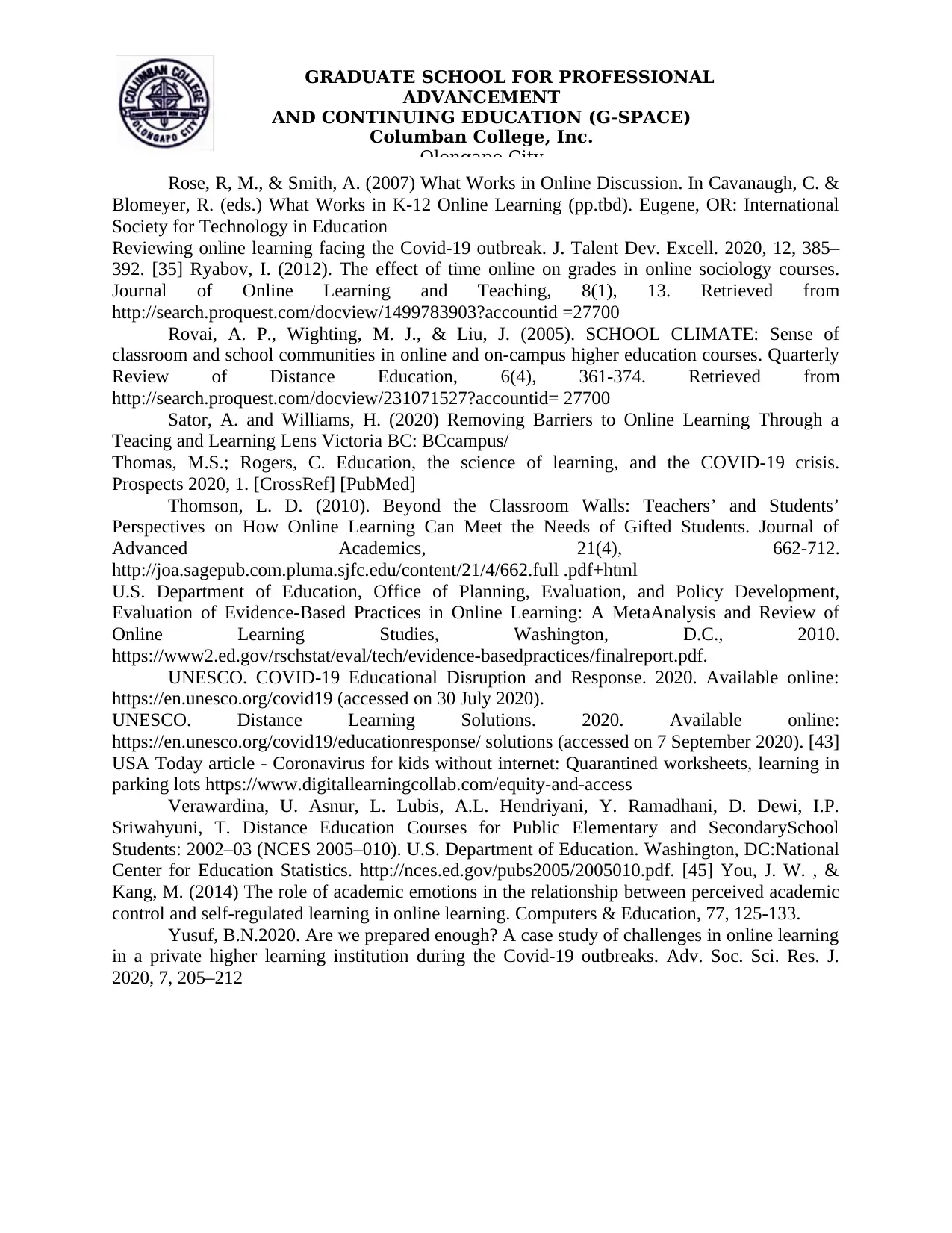
GRADUATE SCHOOL FOR PROFESSIONAL
ADVANCEMENT
AND CONTINUING EDUCATION (G-SPACE)
Columban College, Inc.
Olongapo City
Rose, R, M., & Smith, A. (2007) What Works in Online Discussion. In Cavanaugh, C. &
Blomeyer, R. (eds.) What Works in K-12 Online Learning (pp.tbd). Eugene, OR: International
Society for Technology in Education
Reviewing online learning facing the Covid-19 outbreak. J. Talent Dev. Excell. 2020, 12, 385–
392. [35] Ryabov, I. (2012). The effect of time online on grades in online sociology courses.
Journal of Online Learning and Teaching, 8(1), 13. Retrieved from
http://search.proquest.com/docview/1499783903?accountid =27700
Rovai, A. P., Wighting, M. J., & Liu, J. (2005). SCHOOL CLIMATE: Sense of
classroom and school communities in online and on-campus higher education courses. Quarterly
Review of Distance Education, 6(4), 361-374. Retrieved from
http://search.proquest.com/docview/231071527?accountid= 27700
Sator, A. and Williams, H. (2020) Removing Barriers to Online Learning Through a
Teacing and Learning Lens Victoria BC: BCcampus/
Thomas, M.S.; Rogers, C. Education, the science of learning, and the COVID-19 crisis.
Prospects 2020, 1. [CrossRef] [PubMed]
Thomson, L. D. (2010). Beyond the Classroom Walls: Teachers’ and Students’
Perspectives on How Online Learning Can Meet the Needs of Gifted Students. Journal of
Advanced Academics, 21(4), 662-712.
http://joa.sagepub.com.pluma.sjfc.edu/content/21/4/662.full .pdf+html
U.S. Department of Education, Office of Planning, Evaluation, and Policy Development,
Evaluation of Evidence-Based Practices in Online Learning: A MetaAnalysis and Review of
Online Learning Studies, Washington, D.C., 2010.
https://www2.ed.gov/rschstat/eval/tech/evidence-basedpractices/finalreport.pdf.
UNESCO. COVID-19 Educational Disruption and Response. 2020. Available online:
https://en.unesco.org/covid19 (accessed on 30 July 2020).
UNESCO. Distance Learning Solutions. 2020. Available online:
https://en.unesco.org/covid19/educationresponse/ solutions (accessed on 7 September 2020). [43]
USA Today article - Coronavirus for kids without internet: Quarantined worksheets, learning in
parking lots https://www.digitallearningcollab.com/equity-and-access
Verawardina, U. Asnur, L. Lubis, A.L. Hendriyani, Y. Ramadhani, D. Dewi, I.P.
Sriwahyuni, T. Distance Education Courses for Public Elementary and SecondarySchool
Students: 2002–03 (NCES 2005–010). U.S. Department of Education. Washington, DC:National
Center for Education Statistics. http://nces.ed.gov/pubs2005/2005010.pdf. [45] You, J. W. , &
Kang, M. (2014) The role of academic emotions in the relationship between perceived academic
control and self-regulated learning in online learning. Computers & Education, 77, 125-133.
Yusuf, B.N.2020. Are we prepared enough? A case study of challenges in online learning
in a private higher learning institution during the Covid-19 outbreaks. Adv. Soc. Sci. Res. J.
2020, 7, 205–212
ADVANCEMENT
AND CONTINUING EDUCATION (G-SPACE)
Columban College, Inc.
Olongapo City
Rose, R, M., & Smith, A. (2007) What Works in Online Discussion. In Cavanaugh, C. &
Blomeyer, R. (eds.) What Works in K-12 Online Learning (pp.tbd). Eugene, OR: International
Society for Technology in Education
Reviewing online learning facing the Covid-19 outbreak. J. Talent Dev. Excell. 2020, 12, 385–
392. [35] Ryabov, I. (2012). The effect of time online on grades in online sociology courses.
Journal of Online Learning and Teaching, 8(1), 13. Retrieved from
http://search.proquest.com/docview/1499783903?accountid =27700
Rovai, A. P., Wighting, M. J., & Liu, J. (2005). SCHOOL CLIMATE: Sense of
classroom and school communities in online and on-campus higher education courses. Quarterly
Review of Distance Education, 6(4), 361-374. Retrieved from
http://search.proquest.com/docview/231071527?accountid= 27700
Sator, A. and Williams, H. (2020) Removing Barriers to Online Learning Through a
Teacing and Learning Lens Victoria BC: BCcampus/
Thomas, M.S.; Rogers, C. Education, the science of learning, and the COVID-19 crisis.
Prospects 2020, 1. [CrossRef] [PubMed]
Thomson, L. D. (2010). Beyond the Classroom Walls: Teachers’ and Students’
Perspectives on How Online Learning Can Meet the Needs of Gifted Students. Journal of
Advanced Academics, 21(4), 662-712.
http://joa.sagepub.com.pluma.sjfc.edu/content/21/4/662.full .pdf+html
U.S. Department of Education, Office of Planning, Evaluation, and Policy Development,
Evaluation of Evidence-Based Practices in Online Learning: A MetaAnalysis and Review of
Online Learning Studies, Washington, D.C., 2010.
https://www2.ed.gov/rschstat/eval/tech/evidence-basedpractices/finalreport.pdf.
UNESCO. COVID-19 Educational Disruption and Response. 2020. Available online:
https://en.unesco.org/covid19 (accessed on 30 July 2020).
UNESCO. Distance Learning Solutions. 2020. Available online:
https://en.unesco.org/covid19/educationresponse/ solutions (accessed on 7 September 2020). [43]
USA Today article - Coronavirus for kids without internet: Quarantined worksheets, learning in
parking lots https://www.digitallearningcollab.com/equity-and-access
Verawardina, U. Asnur, L. Lubis, A.L. Hendriyani, Y. Ramadhani, D. Dewi, I.P.
Sriwahyuni, T. Distance Education Courses for Public Elementary and SecondarySchool
Students: 2002–03 (NCES 2005–010). U.S. Department of Education. Washington, DC:National
Center for Education Statistics. http://nces.ed.gov/pubs2005/2005010.pdf. [45] You, J. W. , &
Kang, M. (2014) The role of academic emotions in the relationship between perceived academic
control and self-regulated learning in online learning. Computers & Education, 77, 125-133.
Yusuf, B.N.2020. Are we prepared enough? A case study of challenges in online learning
in a private higher learning institution during the Covid-19 outbreaks. Adv. Soc. Sci. Res. J.
2020, 7, 205–212
1 out of 12
Your All-in-One AI-Powered Toolkit for Academic Success.
+13062052269
info@desklib.com
Available 24*7 on WhatsApp / Email
![[object Object]](/_next/static/media/star-bottom.7253800d.svg)
Unlock your academic potential
© 2024 | Zucol Services PVT LTD | All rights reserved.

